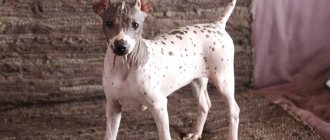Everyone who manages to meet this proud, exotic animal receives a powerful surge of positive emotions. The Thai Ridgeback is a representative of a valuable, rare breed. There are no more than 400 individuals of these magnificent beauties in Russia.
The dog's strong, athletic body, its unusual color, shiny smooth skin, and elegant appearance evoke admiration. This is a miracle of artistic perfection created by nature.
Description of the Thai Ridgeback breed
An amazing, magnificent, unique animal - all this is about the Thai Ridgeback. Have you met a blue dog somewhere? This means that you have seen an individual of this breed. Today, the Thai Ridgeback, whose breed description includes many positive characteristics of the animal, is a rarity in our country.
This breed is ancient. Thailand is considered the homeland of these dogs, outside of which almost no one knows these dogs. As archaeologists note, the history of the breed dates back about 4,000 years. Images of dogs, the description of which has much in common with today's Ridgeback, were found in drawings of Thai rocks. Written references to dogs date back to the 17th century.
The ancestors of these dogs are wild dingoes. For many centuries, representatives of the breed have maintained their typical appearance - these animals have never crossed with other dogs. The reason for this was the long isolation of the animals’ homeland from the outside world. If you compare old and new photographs of these amazing dogs, there is almost no difference.
An excellent dog, the Thai Ridgeback, accompanied its owner on the hunt, and was used as a guard. Individuals of the breed helped in herding livestock and acted as excellent protectors.
The breed was officially recognized in 1989. It was then that it was recognized by the Asian Dog Breeding Union. And a year later, Japanese dog experts also joined them. Three years later, this breed was legalized by the International Association of Cynologists, and its standard and description were established. Currently, these dogs are bred in Europe and America. However, according to official data, there are 2,000 individuals of the breed worldwide. It is for this reason that these dogs are considered the rarest on the planet.
Representatives of the breed are medium in size, they have developed muscles and an athletic build. The fur is short but dense; there is a ridge formed by fur on the back. The crest is also called a ridge. It is formed by fur that grows against the direction of hair growth. The ridge begins at the top of the body and descends along the ridge line. Its length varies, however, there are a number of requirements for its shape - the comb must be symmetrical and not extend beyond the sides.
There are several types of Thai fur:
There are 4 types of color: it can be red, black, blue, isabella. The most common colors are red and black, however, the other two types are considered rare. The length of males is 61 cm, females - up to 56 cm with a weight of 32-28 kg, respectively.
Representatives of the breed have large ears set quite high. The eyes are dark brown or amber, the large nose is dark in color. Wrinkles are clearly visible on the forehead. They are the ones who give the dog seriousness. The dog is very emotional, all emotions are immediately visible on the face.
Reviews
Alexandra P.:
I came across an infinitely intelligent, but willful and capricious individual with the character of a cat. And yet, with her presence, joy settled in the house. A positive dog, a love dog and a companion dog. Three in one. One drawback is its difficult nature, and it’s also expensive.
Alexander:
Our hellish mixture of love and stupidity is 8 months old. Half of this time is continuous training with dog handlers. I have to admit that this is a dog for those who are well acquainted with the breed and the intricacies of education, and is not suitable for a family with a small child.
Zhenya:
My Riji is stately and handsome, the most loyal, but he is so difficult to deal with. You have to consult regularly, on almost every issue.
Katerina:
We have a very affectionate, most gentle and shy girl. Still shy and artistic. We love her madly, she is so beautiful. But I never, under any circumstances, advise anyone to adopt this breed if they have no experience in raising dogs. Socialize from birth, educate before you are born. We changed coaches four (!!!) times just to begin the education process.
If anyone is in the know, tell us about the most extraordinary dog – the Thai Ridgeback. Share your knowledge about the breed. How to navigate each critical stage in a dog's development and how to achieve mutual understanding. Which toys are better, and should the issue of training be raised during walks? We welcome your feedback, which can be posted at the bottom of the article.
Share
Leave a review
Character specifics
Also, the description of the Thai Ridgeback includes the character traits of the animal. These dogs are independent and tactful. In this way, their behavior is similar to that of cats. At the same time, individuals of this breed cannot tolerate loneliness; these dogs should not be kept in an enclosure.
Thais can live in an apartment, they are very clean animals, odorless.
Representatives of the breed are devoted to the family and the owner, they become attached to all family members, they need attention. At the same time, they are very wary and wary of strangers.
Males are more aggressive and playful, which makes them excellent guards, watchmen, and defenders.
Representatives of the breed have excellent hearing, dexterity and grace. They often make decisions on their own. There is no need to use force during the training process - dogs do not tolerate rudeness. However, they are greedy for affection and all kinds of encouragement.
These animals are quite resourceful and inventive. Because of their excellent memory, they are almost instantly amenable to education and training, but only if they trust and respect the owner. The main thing in this case is patience.
Thais have a friendly disposition, which is why they get along well with other pets. However, outside the home, dogs will not mind running after street animals. Individuals of this breed get along well with children and can tolerate all the antics of kids. They love to run and play.
This breed is characterized by emotionality and sensitivity. These animals are not suitable for unbalanced, angry, nervous people. The dog cannot tolerate rough treatment.
Any Thai Ridgeback, whose character is similar to that of a cat, does not always treat strangers favorably; he looks closely at them for a considerable period of time. Like cats, individuals of this breed have a territorial type of behavior - they feel completely at ease exclusively in their own territory, and do not like to leave it. In addition, these dogs do not like water.
Content
Individuals of this breed can live in an apartment. They do not have a specific odor, and they do not shed often or significantly. The dogs are very active and mobile. They need the attention of the owner - pets should be handled, taught, trained, introduced to other pets, and socialized. An adult dog will be an excellent companion when jogging or cycling.
Representatives of the breed are very clean; they do not like dirt. For this reason, your pet should wipe its paws after walking. The animal must be washed once every three months. During the molting period, it is necessary to regularly comb the dog using a brush or a hard mitten.
Young pets should be walked for about two hours every day and exposed to physical activity. For adults, 2 walks of half an hour every day are enough.
At the same time, the Thai Ridgeback dog breed is an animal that should not be kept on the street, since it needs to be constantly with the family.
Individuals of this breed are also picky when it comes to nutrition. They can be fed prepared food or natural food. But at the same time, vitamins and all kinds of supplements must be present in the animal’s diet. It is necessary to carefully monitor that the dog does not overeat, as this can lead to significant health problems in the future. In addition, the pet must always have free access to water.
Nutrition
When feeding puppies, you should follow the clear recommendations of the breeder of the nursery where the baby was purchased. As a rule, Thai Ridgebacks are feeders. They are selected with super-premium food for energetic breeds, the diet of which helps maintain the dog’s elegant appearance and ensures rapid weight gain without compromising the bone structure.
It is advisable not to switch to feeding natural products, since it is quite difficult to choose a balanced diet in which the dog does not lose its grace, and at the same time is well-fed.
But fruits and vegetables are not contraindicated for dogs within reasonable limits. Like all hunters, TRDs are very fond of raw meat. You should consult with the breeder and your veterinarian about adding it to the diet.
Peculiarities
These dogs are among the rarest breeds with an exotic appearance. If the assessment of appearance can be made from photographs, then the unusualness of the short velvet fur is purely by touch. There is one more feature - the tongue is blue. And this also happens among Thais, but extremely rarely. You can meet a blue dog. The beautiful Thai Ridgeback, whose breed description and character has many advantages, has an athletic build, velvety fur, and a conscious, intelligent facial expression. It is these characteristics that make representatives of the breed a real dream for a large number of dog breeders. Blue dogs look unusual, unique, beautiful, impressive.
Training
Ridgebacks are very smart and resourceful dogs. They love to repeat the actions of their owner. However, these dogs remember commands best if training takes place in the form of a game.
You can start training a Ridgeback from the age of four months. It is best if the training is conducted by an experienced trainer who knows all the nuances of this breed. The owner can reinforce the learned commands while walking the dog.
Historical reference
The first mentions of the breed are found in manuscripts and drawings dating back to the 16th–17th centuries. Initially, Thai Ridgebacks were common in Thailand, Indonesia and Vietnam. They were used to hunt wild boar, deer and birds, and they also accompanied important people on their travels. The dogs' habitat was isolated from the outside world, so their appearance remained unchanged for a long time.
With the advent of modern vehicles, dogs with hoists spread throughout Southeast Asia and the rest of the world. In the 19th century, four-legged lovers discovered dogs with ridges on the Vietnamese island of Phu Quoc and identified them as a separate breed. In 1993, the International Canine Organization officially registered Thai Ridgebacks and approved the standard.
Appearance
The Thai Bangku is a harmonious, anatomically correctly built dog of a square format with double hair and a rather deep, wide chest, not squat. Sexual dimorphism is well expressed. Males are taller, weigh more, have a more developed bone structure and more decorative coat.
- Height at the withers of males - 46-55 cm;
- Height at the withers of females is 41-50 cm.
The head is proportional to the body. Wedge-shaped skull. Stop moderate. The muzzle is of medium length, gradually tapering to a black nose. The bridge of the nose is straight. The jaws are strong and have a scissor bite. The eyes are almond-shaped, medium in size, black or dark brown in color. The ears are triangular, small, set high, erect, slightly tilted forward.
Square format case. The back is strong and straight. The loin is wide. The croup is moderately sloping. The chest is deep, rather wide, reaching below the elbows. The ribs are well sprung. The hemline is slightly tucked. The tail is of moderate length, carried in a curve rising over the back. The limbs are straight and strong, parallel when viewed from front and rear, well balanced. The paws are round, collected, arched.
The coat is double, formed by straight, coarse outer coat and dense, soft undercoat. The hair on the body is of moderate length. A collar forms around the neck and on the shoulders. Itching on the back of the forearms, thighs and legs. The hair on the head and front of the legs is short. The color is white with clearly demarcated spots of lemon, fawn, red, tan, black or gray. With or without dark tips. Spots of any shape and location. Symmetrical on the face is preferred. A dark mask may be present. A white blaze on the forehead is desirable.
Character traits
Ridgebacks have an independent but loyal nature. Males tend to be dominant, while females are friendly and love affection. Dogs of this breed quickly become attached to their family members. Developed intelligence and observation allow them to pick up intonations, so they listen with special attention to human voices.
Young representatives of the breed are very active and cannot stand loneliness. They need attention and long walks. As animals grow older, they become lazier and love comfort and sleep.
These dogs get along well with children, enjoy playing games with them and forgive them for any pranks. They are loyal to other pets, but only if they grew up with them. Thai Ridgebacks do not trust strangers, but they are not suitable for the role of a guard due to a lack of aggression. However, their frowning appearance and stately physique make them look like fighting dogs, so few people would want to encroach on their territory.
How to choose a puppy
When choosing Thai Ridgeback puppies, you need to clearly understand that this energetic animal will not sit on the couch next to its owner all day; it will have to spend a lot of time caring for it, raising it, training it, and walking it. If this issue is resolved, all that remains is to choose the right pet:
- It is necessary to find a nursery where puppies with a pedigree are kept. If it is not there, you need to think about the vices of the parents, which will certainly be passed on to the baby.
- Competent breeders know that along with the puppy it is necessary to hand over a veterinary passport, a memo to the owner and FCI documents.
- Before purchasing, you need to check: timely branding, all vaccinations, a course of treatment with anthelmintic drugs.
- When choosing a dog from the litter, you need to pay attention to the most curious and active baby.
Don't focus on the folds of your skin. They disappear as the dog gets older. The price for a Thai Ridgeback will not be small.
This is a valuable and rare breed. It ranges from 100,000 rubles to 1 million . However, you should not buy such a dog at a poultry market or secondhand. This is fraught with any fake. A pet must be chosen only in a nursery with all the documents confirming its purebredness and health status.
Note! When raising a dog, the owner must learn one truth: all failures are his own fault, no matter how offensive it may seem. The pet is always right. If something doesn’t work out, you need to consult a dog handler.
The owner, who dared to pay a large sum of money for a Ridgeback puppy, obviously thought through all the pros and cons of such an acquisition. A beautiful, intelligent animal will appear in the house, with magnificent original colors, affectionate, faithful and obedient. The owner will spend a single day to raise, educate and train him, for which he will be rewarded by communicating with his beloved pet, loyal and fearless.
Pros and cons of the breed
You should only purchase a puppy from experienced breeders. Before purchasing, you need to make sure that the baby has a puppy certificate and a veterinary passport, which contains the dates of vaccinations given. New owners should familiarize themselves with the pedigrees of the parents of the future pet in order to exclude the development of genetic diseases and have an idea of the external characteristics of the animal.
Care and maintenance
Thais can be kept in a city apartment or in the courtyard of a private house. These animals have short fur, so in the cold season they should be kept in a heated room, and during walks they should wear warm overalls. Representatives of the breed cannot be chained, as they are very active, do not like loneliness and need free space.
Caring for Ridgebacks includes the following procedures:
- Twice a week the wool is combed out with a special rubber glove. Such manipulations improve blood circulation and allow you to get rid of dead hair.
- Pets should be bathed no more than once every three months with shampoo for short-haired dogs.
- The corners of the eyes are regularly wiped with a soft cloth dipped in warm water.
- The ears are cleaned once a week using cotton swabs. The procedure is performed carefully so as not to damage the auricle.
- Nails are trimmed once a month with a nail clipper for large breeds.
- Teeth are brushed regularly with a special toothpaste for dogs. Tartar is removed in a veterinary clinic.
Thai Ridgebacks love to show their independence and perseverance. From the first days of the puppy’s stay in the house, it is necessary to start raising it. During training, the owner must show confidence and patience. Cruel methods should not be used so as not to disturb the animal’s psyche. For correct execution of commands, the pet is rewarded with a treat.
Socialization should begin at four months of age. The dog must be walked in public places and introduced to other animals. To learn security and hunting skills, your pet should be sent for professional training. Considering the psychological characteristics of the breed, there is no need to take long breaks between classes.
Breed diseases
The Thais do not yet have many generations of crossbreeding in order to obtain an exact match to the standard, therefore in their blood they have a predisposition to only two diseases:
- Hip dysplasia develops in dogs that weigh too much and jump too high - at some point the joint capsule is damaged and the paw becomes twisted. To fix this, surgery will be required.
- The dermoid sinus develops during intrauterine development - the skin is formed incorrectly, as a result of which an ulcer forms on it, as if turned inside out.
There are no more predispositions: neither to allergies, nor to diseases of the sensory organs, nor to disturbances in the functioning of the gastrointestinal tract. Thais live on average 12-13 years.
Mating and care of offspring
The first heat in females of this breed begins at the age of 12 to 14 months, its duration is about 22 days. Dogs should be bred when they reach two years of age. The ideal period for mating is considered to be the 11th–15th day from the start of estrus. Before mating, animals need to be given a good walk. Sexual intercourse must take place on the territory of the male dog. After 1–2 days, mating is repeated to consolidate the result.
Pregnancy lasts from 56 to 72 days. During this period, dogs' mammary glands swell, drowsiness and apathy are observed. Before giving birth, bitches have a drooping belly.
Childbirth must be carried out under the supervision of a veterinarian. The nose and mouth of newborn puppies should be wiped with a clean cloth to prevent them from suffocating. After giving birth, the dog will take care of its offspring on its own. The new mother will feed the babies and lick them to stimulate the intestines.
Suitable nicknames
The pet's name will need to be spoken many times a day, so it should be short and sonorous. When choosing a nickname, you can be guided by the following methods:
- Find a list of names suitable for the breed on the Internet and choose the one you like best.
- Come up with a unique nickname yourself.
- Name the dog after a mythical character, favorite movie character, city or actor.
The following names are suitable for girls:
Boys can be given the following nicknames:
Natural selection played an important role in the formation of the breed, so Ridgebacks have strong immunity. To avoid health problems, you must adhere to the following recommendations:
- Be examined at a veterinary clinic several times a year.
- Vaccinate pets annually.
- Give anthelmintic drugs (Prazicide suspension, Drontal) once every three months.
- Treat dogs for fleas and ticks monthly from March to November (Advocate, Dana).











